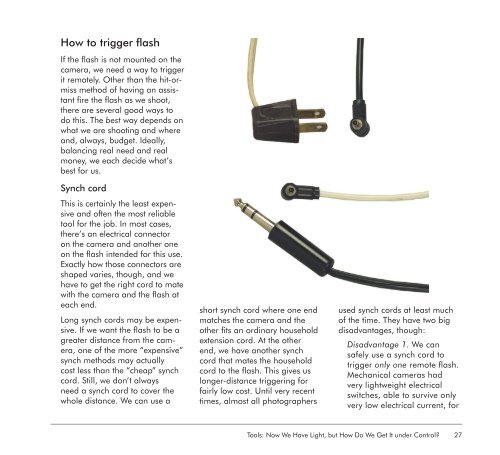Focus On Lighting Photos Focus on the Fundamentals.pdf
You also want an ePaper? Increase the reach of your titles
YUMPU automatically turns print PDFs into web optimized ePapers that Google loves.
How to trigger flash<br />
If <strong>the</strong> flash is not mounted <strong>on</strong> <strong>the</strong><br />
camera, we need a way to trigger<br />
it remotely. O<strong>the</strong>r than <strong>the</strong> hit-ormiss<br />
method of having an assistant<br />
fire <strong>the</strong> flash as we shoot,<br />
<strong>the</strong>re are several good ways to<br />
do this. The best way depends <strong>on</strong><br />
what we are shooting and where<br />
and, always, budget. Ideally,<br />
balancing real need and real<br />
m<strong>on</strong>ey, we each decide what’s<br />
best for us.<br />
Synch cord<br />
This is certainly <strong>the</strong> least expensive<br />
and often <strong>the</strong> most reliable<br />
tool for <strong>the</strong> job. In most cases,<br />
<strong>the</strong>re’s an electrical c<strong>on</strong>nector<br />
<strong>on</strong> <strong>the</strong> camera and ano<strong>the</strong>r <strong>on</strong>e<br />
<strong>on</strong> <strong>the</strong> flash intended for this use.<br />
Exactly how those c<strong>on</strong>nectors are<br />
shaped varies, though, and we<br />
have to get <strong>the</strong> right cord to mate<br />
with <strong>the</strong> camera and <strong>the</strong> flash at<br />
each end.<br />
L<strong>on</strong>g synch cords may be expensive.<br />
If we want <strong>the</strong> flash to be a<br />
greater distance from <strong>the</strong> camera,<br />
<strong>on</strong>e of <strong>the</strong> more “expensive”<br />
synch methods may actually<br />
cost less than <strong>the</strong> “cheap” synch<br />
cord. Still, we d<strong>on</strong>’t always<br />
need a synch cord to cover <strong>the</strong><br />
whole distance. We can use a<br />
short synch cord where <strong>on</strong>e end<br />
matches <strong>the</strong> camera and <strong>the</strong><br />
o<strong>the</strong>r fits an ordinary household<br />
extensi<strong>on</strong> cord. At <strong>the</strong> o<strong>the</strong>r<br />
end, we have ano<strong>the</strong>r synch<br />
cord that mates <strong>the</strong> household<br />
cord to <strong>the</strong> flash. This gives us<br />
l<strong>on</strong>ger-distance triggering for<br />
fairly low cost. Until very recent<br />
times, almost all photographers<br />
used synch cords at least much<br />
of <strong>the</strong> time. They have two big<br />
disadvantages, though:<br />
Disadvantage 1. We can<br />
safely use a synch cord to<br />
trigger <strong>on</strong>ly <strong>on</strong>e remote flash.<br />
Mechanical cameras had<br />
very lightweight electrical<br />
switches, able to survive <strong>on</strong>ly<br />
very low electrical current, for<br />
Tools: Now We Have Light, but How Do We Get It under C<strong>on</strong>trol? 27



